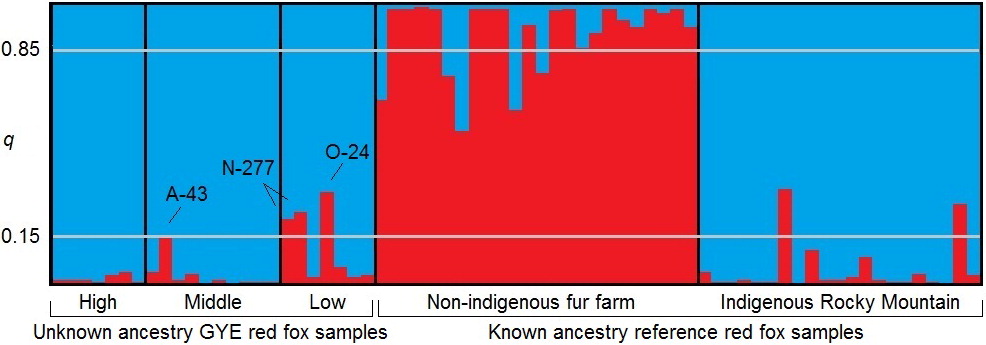Red Fox Ancestry and Connectivity Assessments Reveal Minimal Fur Farm Introgression in Greater Yellowstone Ecosystem
Patrick R. Cross, Benjamin N. Sacks, Gordon Luikart, Michael K. Schwartz, Keith W. Van Etten, and Robert L. Crabtree
Journal of Fish and Wildlife Management, Vol. 9, No. 2, pp. 519-530.
2018
Rocky Mountain red foxes Vulpes vulpes macroura potentially encounter other red fox Vulpes vulpes lineages at lower elevations, which may include nonindigenous red foxes derived from fur farms. Introgression from nonindigenous red foxes could have negative evolutionary consequences for the rare Rocky Mountain red fox subspecies. Red foxes at high elevations in the Greater Yellowstone Ecosystem exhibit lighter coat colors than those at lower elevations, potentially indicating that they represent the indigenous subspecies and that gene flow across the elevational gradient is restricted. We collected tissue samples across a 1,750-m elevation range and examined mitochondrial DNA sequences and nuclear DNA microsatellite genotypes to assess the ancestry and genetic population structure of red foxes in the northern Greater Yellowstone Ecosystem. We also used reference samples from fur farm red foxes and indigenous red foxes of the western United States to assess the extent of nonindigenous introgression across the ecosystem. We found little overlap in the elevational distribution of maternally inherited mitochondrial DNA haplotypes: above 1,600 m, we only found indigenous Rocky Mountain haplotypes (n = 4), whereas below 1,600 m, we found haplotypes not indigenous to the Rocky Mountains (n = 5) that were associated with fur farms or indigenous to the Great Plains. In contrast, biparentally inherited microsatellite variation showed little population structure across the elevational gradient. Despite this evidence of nuclear gene flow across the elevational gradient, we found little fur farm introgression in the microsatellite genotypes. It is possible that long-standing nuclear (but apparently not mitochondrial) gene flow between Rocky Mountain red foxes and indigenous red foxes on the Great Plains explained the low nuclear differentiation of these populations. Importantly, our results suggested that high elevations of the northern Greater Yellowstone Ecosystem remained free of significant fur farm introgression. Mitonuclear discordance could reflect sex-biased dispersal, which we hypothesize could be the effect of elevational differences in reproductive phenology.

